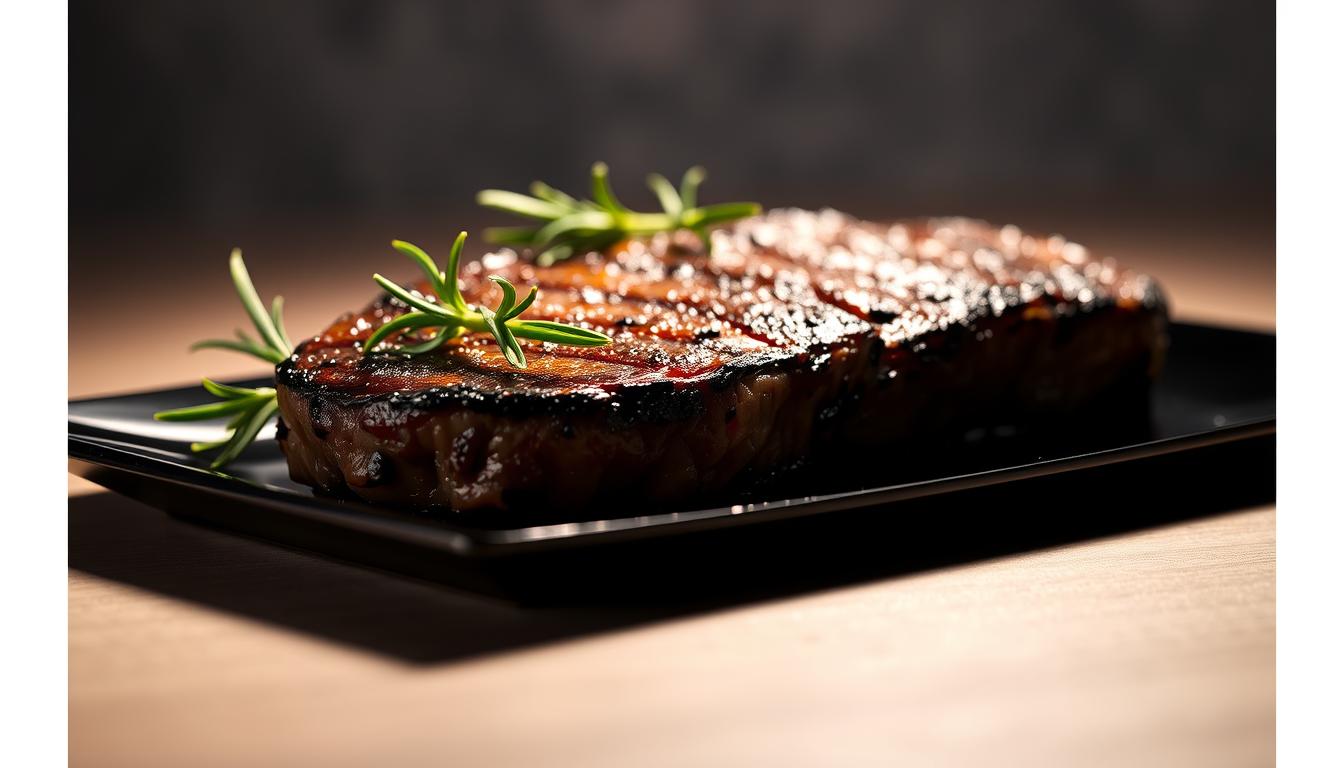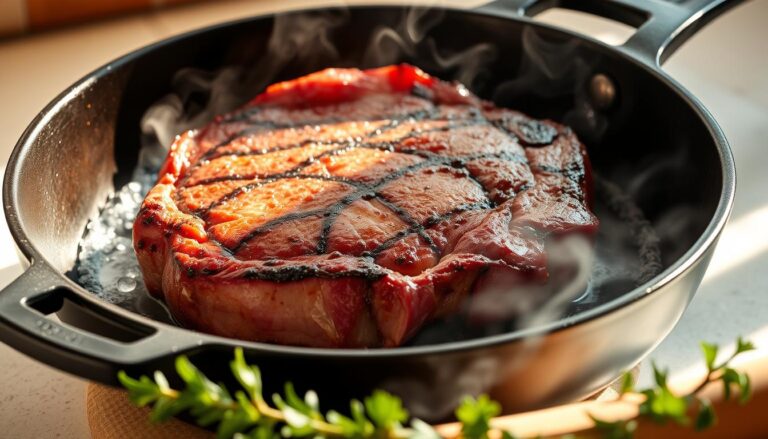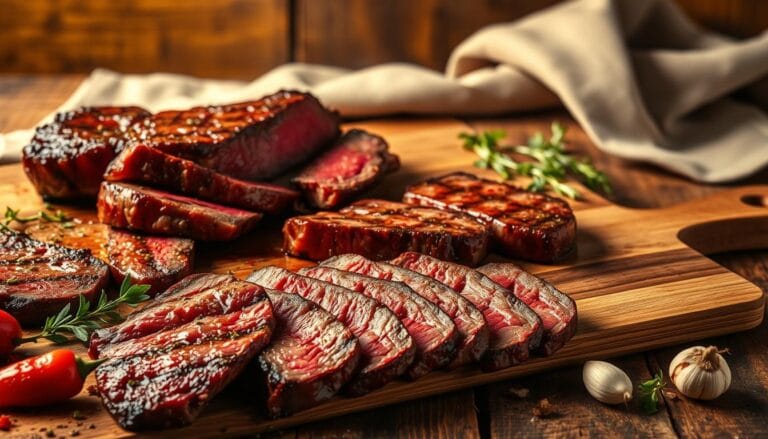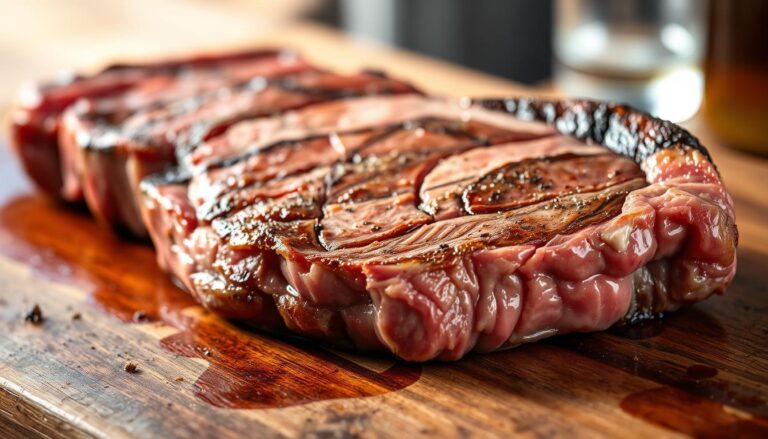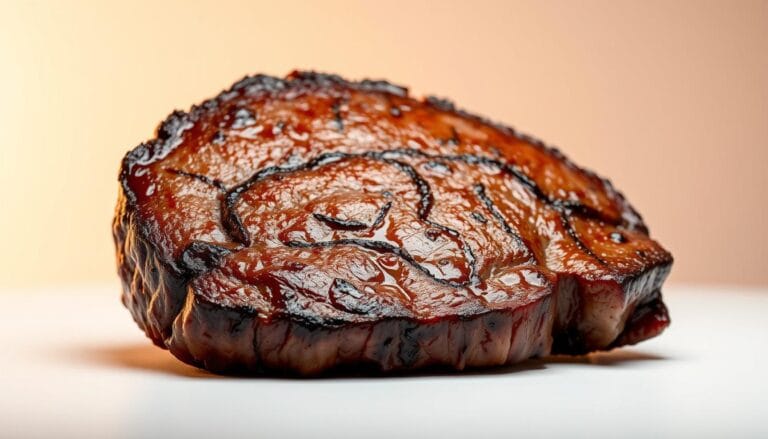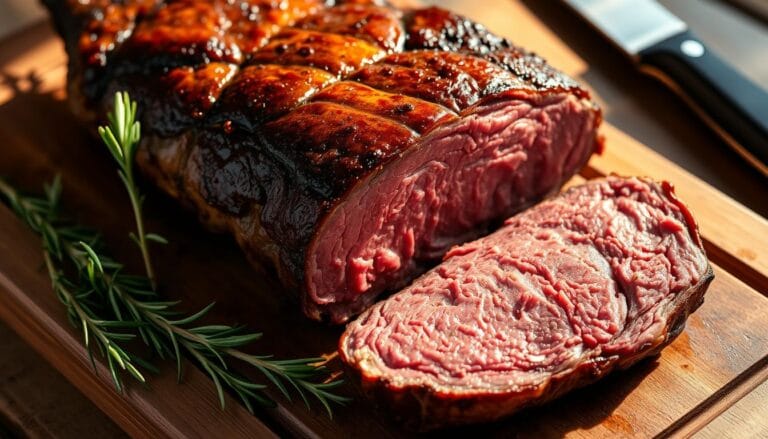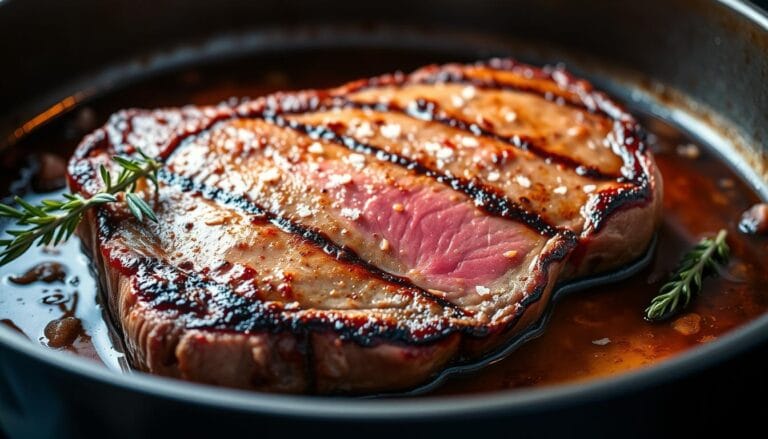what is hanger steak : The Underrated Beef Cut You Need to Try
Table of Contents
what is hanger steak : The Underrated Beef Cut You Need to Try
Are you tired of cooking the same old beef cuts? You’re not alone. Many beef lovers are searching for something new. Discovering hanger steak can be a game-changer. It’s rich in flavor and tender, making it a must-try for anyone looking to elevate their cooking.
This cut comes from the diaphragm of the cow. It offers a unique eating experience that’s both rich and satisfying. For those wondering what makes hanger steak special, it’s the mix of its rich flavor and tender texture. This makes it stand out from more commonly eaten cuts.
Hanger steak is a flavorful and tender beef cut that is gaining popularity among food enthusiasts. Originating from the diaphragm of the cow, this cut offers a rich and satisfying eating experience, setting it apart from more traditional options. If you’re looking to elevate your culinary adventures, hanger steak is definitely worth a try.
Key Takeaways
- Understanding the unique characteristics of hanger steak.
- Learning how to select the perfect cut for your needs.
- Mastering proper cooking techniques to bring out its best flavors.
- Exploring various ways to incorporate hanger steak into your meals.
- Discovering why hanger steak is considered a “butcher’s secret”.
What is Hanger Steak?
The hanger steak is a special cut of beef from the cow’s plate section. It comes from the diaphragm muscle. Butchers loved it so much, they kept it for themselves, calling it “butcher’s steak.”
Definition and Origins
The hanger steak is named for its spot in the cow. It “hangs” from the diaphragm, supporting the organs. Each cow has only one, weighing 1-2 pounds.
This rare cut is loved by chefs and meat lovers. Its rich flavor makes it very special.
Unique Characteristics
The hanger steak looks different. It’s long and has a unique shape. It also has a tough, inedible membrane in the middle.
It’s red because of its high myoglobin. This makes it taste beefy. The loose grain absorbs marinades well, keeping the flavor strong.
A key feature of hanger steak is its ability to absorb flavors. The loose grain lets marinades soak in deep. This makes hanger steak great for many dishes.
Why Hanger Steak is Underrated
The hanger steak is often overlooked, despite its rich flavor and tender texture. It’s not as well-known as other cuts, mainly because it’s less available and hasn’t been marketed much. But, once you learn about its qualities, you’ll see why it’s a cut worth trying.
Flavor Profile
The hanger steak has a bold and unique flavor profile. Its taste is more intense than cuts like ribeye or tenderloin. This is because it’s located near the diaphragm and kidney, where it absorbs more of the animal’s natural flavors.
“The hanger steak has a complexity that is hard to find in other cuts.”
It has complex mineral notes that beef lovers enjoy. Some say it tastes slightly gamey or iron-rich. This makes it stand out from milder cuts and is a hit with those who love a strong beef flavor.
Tenderness
Hanger steak is tender, but not as soft as some premium cuts. It’s all about how you prepare and cook it. When sliced right, it has a great chew that many prefer over very tender cuts.
| Characteristics | Hanger Steak | Ribeye | Filet Mignon |
|---|---|---|---|
| Flavor Profile | Robust, beefy | Rich, marbled | Mild, tender |
| Tenderness | Moderate | Moderate to High | High |
| Texture | Satisfying chew | Marbled, tender | Buttery, tender |
To get the best results, cook hanger steak by grilling or pan-searing. Don’t overcook it. Its marbling keeps it juicy, even when cooked to medium-rare or medium.
Nutritional Benefits of Hanger Steak
Hanger steak is a top choice for its nutritional value. It’s packed with protein, vitamins, and minerals. This makes it a great option for those wanting to eat healthier.
Protein Content
Hanger steak is a great source of protein. A 3.5-ounce serving has about 23-26 grams. This protein helps with muscle growth and repair.
The protein in hanger steak is easy for your body to use. It’s perfect for those on diets like paleo or keto. It has less fat than cuts like ribeye.
Vitamins and Minerals
Hanger steak is full of vitamins and minerals. It’s rich in B vitamins like B12 and B6. These vitamins are key for nerve health and brain function.
- It gives you a big chunk of your daily B vitamins.
- Hanger steak has minerals that many people don’t get enough of.
- It has heme iron, which is great for preventing anemia.
Comparison to Other Cuts
Hanger steak has more fat than lean cuts like sirloin. But it has less fat than cuts like ribeye. This makes it taste richer.
A 3.5-ounce serving of hanger steak has 170-190 calories. It has a good balance of fats. This is good for those watching their fat intake.
How to Choose the Best Hanger Steak
Choosing the best hanger steak needs careful attention and a basic understanding of beef quality. At the butcher or market, look for several key factors to ensure a high-quality hanger meat cut.
What to Look For in Quality
First, check the color of the hanger steak cut. It should be a deep, vibrant red, not the bright red of other cuts. This color shows it’s fresh and not old.
Look for moderate marbling, which is thin streaks of white fat in the meat. While hanger steak doesn’t have a lot of marbling, it should have some.
The meat should look moist but not slimy. Gently press it; it should feel firm but springy. It should smell fresh, not sour or ammonia-like.
Each piece usually weighs 8-16 ounces after trimming. The whole hanger steak from one animal is 1-2 pounds before trimming. Make sure it’s been trimmed well, with excess silverskin and tough membranes removed.
Grading Explained
Understanding beef grading systems helps you pick the best hanger steak cut. In the U.S., the USDA grades beef based on marbling and maturity. Prime is the highest quality, followed by Choice and Select.
Hanger steak isn’t as marbled as some cuts, but a Prime or high Choice grade will be tender and flavorful. But, specialty butchers and high-end suppliers might use other grading systems.
Some beef is graded by cattle breed, like Angus or Wagyu. This affects the steak’s quality. Others highlight how the beef was raised, like grass-fed or organic. Grass-fed hanger steak is leaner and has a stronger flavor, while grain-finished is milder.
Dry-aged hanger steak is less common but has a more complex flavor. When picking your hanger meat cut, remember that USDA Prime is great, but breed, feeding, and aging also matter.
Preparing Hanger Steak at Home
To get the most out of hanger steak, picking the right cooking method is key. This cut of beef is known for its rich taste and tender feel when cooked right.
Recommended Cooking Methods
Quick, high-heat cooking methods usually work best for hanger steak. Grilling is a favorite, as it sears the outside fast while keeping the inside juicy. Cast iron pan-searing is also great, as it adds a tasty crust. Heat your skillet until it’s almost smoking, use a high smoke-point oil, and cook for 3-4 minutes per side for medium-rare.
Broiling is another good choice, perfect when grilling isn’t an option. Place your oven rack 4-6 inches from the heat and cook for the same time as grilling. For a more precise method, sous vide followed by a quick sear is excellent, giving you exact temperature control.
Marinades and Seasonings
Hanger steak is amazing at soaking up and matching many marinades and seasonings. This makes it very flexible in the kitchen. Acidic marinades, like those with red wine, balsamic vinegar, or citrus, are great. They tenderize the meat and add depth to its flavor.
For dry seasonings, hanger steak loves bold flavors. A simple mix of kosher salt and black pepper about 40 minutes before cooking works well. More complex spice rubs with smoked paprika, cumin, or chili powder can also enhance the meat’s natural taste.
Grilling Hanger Steak: Tips and Tricks
Grilling a hanger steak is an art that requires balancing heat, timing, and technique. This is to bring out its full flavor. To get a perfectly grilled hanger steak, focus on the cooking environment and the meat’s internal temperature.
Temperature Guidelines
Mastering the temperature for grilling a hanger steak cut is key. Preheat your grill to high heat, about 450-500°F (232-260°C). This high heat is important for hanger steak because it’s thin and can overcook quickly at lower temperatures.
When checking the internal temperature of your hanger steak, use a good instant-read thermometer. For a perfect medium-rare, remove the steak when it’s 130-135°F (54-57°C). It will rise about 5°F while resting. For medium doneness, aim for 135-140°F (57-60°C) before resting.
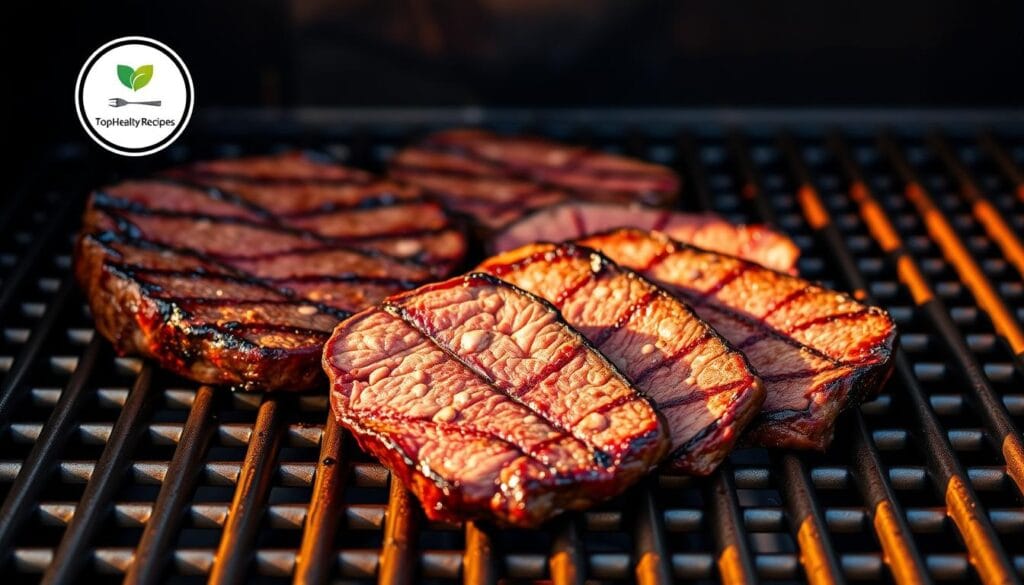
Resting the Meat
Knowing what is hanger steak and how to rest it is key for a great taste. After grilling, move the steak to a cutting board or warm plate. Let it rest, loosely covered with aluminum foil, for 5-10 minutes. This allows for carryover cooking and juices to spread evenly.
To improve resting, some chefs put a small pat of compound butter on the steak. This melts and adds more flavor. After resting, slice the hanger steak against the grain for tenderness.
Cooking Hanger Steak Medium Rare
Cooking hanger steak to medium-rare needs precision and the right methods. This beef cut is known for its rich flavor and tender texture when cooked right. It can be a highlight of any meal. To get the perfect medium-rare, knowing the best cooking methods and doneness indicators is key.
Best Techniques for Medium-Rare
To cook a hanger steak medium-rare, start by letting it come to room temperature. This helps in achieving a more even cook. For pan-searing, preheat a cast-iron skillet until it’s smoking hot. Add a high smoke-point oil, such as grapeseed or clarified butter, before searing the steak for 3-4 minutes on the first side.
Flip it once and cook for an additional 2-3 minutes, adjusting based on the steak’s thickness.
Grilling over a two-zone fire is another good method. It allows for both searing and finishing the steak to the desired doneness without overcooking it. Sear the steak over high heat for 2-3 minutes per side, then move it to the indirect heat zone to finish cooking to an internal temperature of 130-135°F (54-57°C).
The reverse sear method is also effective: start by cooking the steak in a low oven (275°F/135°C) until it reaches an internal temperature of about 115°F (46°C). Then, finish with a quick sear in a hot pan or grill to develop a crust.
Doneness Indicators for Hanger Steak
Understanding the visual and tactile indicators of doneness is key for cooking hanger steak to perfection. While a thermometer provides the most accurate reading, recognizing physical signs can help develop your cooking intuition.
For a medium-rare hanger steak, look for a deep brown, caramelized crust on the exterior. When cut, the interior should display a warm red center gradually transitioning to pink and then to the browned exterior. The touch test can also be useful: a medium-rare steak should feel slightly firmer than rare but less firm than medium.
| Cooking Method | Internal Temperature (°F) | Visual Indicators |
|---|---|---|
| Pan-Searing | 130-135 | Deep brown crust, warm red center |
| Grilling | 130-135 | Caramelized exterior, pink interior |
| Reverse Sear | 130-135 | Crust on exterior, red-pink interior |
By combining these techniques with an understanding of doneness indicators, you can consistently achieve a perfectly cooked medium-rare hanger steak. This steak showcases its unique flavor and tenderness.
Hanger Steak in Different Cuisines
Hanger steak is loved worldwide for its bold taste and soft texture. It’s a favorite in many cultures and cooking styles.
American Cuisine
In the U.S., hanger steak has gone from a secret to a star in fancy restaurants. It’s often seasoned simply with salt, pepper, and sometimes garlic. Then, it’s grilled to bring out its full flavor.
The farm-to-table movement loves hanger steak for its unique taste and ties to whole-animal butchery. It’s often the main dish in plates with fresh veggies and creative sides.
Key preparations include:
- Southern-influenced versions with bourbon glazes or pecan crusts
- Southwestern interpretations featuring chili rubs and corn relishes
- Pacific Northwest approaches pairing the steak with foraged mushrooms and local wines
Latin American Dishes
Latin American cuisines have always cherished hanger steak. In Argentina, it’s called “entraña” and grilled with coarse salt, served with chimichurri.
In Mexico, hanger steak is used in arrachera. It’s marinated in citrus, garlic, and chilies before grilling. This makes it perfect for tacos or as a main course.
Notable Latin American preparations include:
- Brazilian churrascarias, where it’s skewered and roasted over open flames
- Central American “churrasco,” seasoned simply and grilled, then topped with tangy sauces
- Peruvian lomo saltado, where hanger steak is stir-fried with onions, tomatoes, soy sauce, and aji amarillo peppers
Pairing Wine with Hanger Steak
The hanger steak cut has a rich flavor, perfect for wine pairings. The right wine can make your meal better by matching the steak’s bold taste.
Red wines with medium to full body and moderate tannins pair well. For example, Malbec from Argentina is great. It has black fruit flavors and smooth tannins that match the meat well.
Red Wine Recommendations
Cabernet Sauvignon is a classic choice for hanger steak. It has structured tannins and black currant notes that balance the meat’s richness. Syrah/Shiraz is also good, matching the steak’s peppery crust or spice rub.
For acidic sauces like chimichurri, try Chianti Classico. Its acidity and cherry notes balance the sauce’s flavors.
Other Beverage Options
Red wine isn’t the only choice for hanger steak cut. Craft beer is also great. Belgian Dubbels have malty sweetness and spice that match the meat. American brown ales offer a balanced taste with nutty notes.
Bourbon whiskey is a natural match, served neat or with a single ice cube. Its caramel and vanilla notes from oak aging go well with the steak’s caramelized outside.
Non-alcoholic options like cold-brewed coffee or sparkling water with herbs can also pair well. For spicy dishes, horchata or fruit agua fresca can cool down the palate.
Hanger Steak Recipes to Try
The hanger steak cut of beef is a hidden gem. We’ll show you how to unlock its flavors with two mouth-watering dishes. It’s known for its rich flavor and tender texture when cooked right. This makes it an excellent choice for various recipes.
Simple Grilled Hanger Steak
For those wondering what’s a hanger steak’s simplest yet most delicious preparation, try this classic grilled recipe. Start with a 1-1.5 pound hanger steak. Remove any silverskin and the central membrane.
Make a marinade with 3 tablespoons olive oil, 2 tablespoons balsamic vinegar, 3 minced garlic cloves, 1 tablespoon fresh rosemary, and 1 teaspoon each of kosher salt and black pepper. Place the steak and marinade in a resealable plastic bag. Massage to coat evenly and refrigerate for at least two hours or overnight.
Take the steak out of the fridge 45 minutes before cooking. Preheat your grill to high heat (450-500°F). Remove the steak from the marinade, pat dry with paper towels, and season with additional kosher salt and pepper. Grill for 3-4 minutes per side for medium-rare, or until it reaches 130-135°F. Let it rest for 5-10 minutes before slicing thinly against the grain.
Hanger Steak Tacos
This vibrant hanger steak taco recipe turns the hanger steak into a memorable meal. It balances the meat’s rich flavor with bright, complementary components. Prepare a citrus-forward marinade with the juice of 2 oranges, 2 limes, and 1 lemon, 4 minced garlic cloves, 2 tablespoons olive oil, 1 tablespoon each of ground cumin and dried oregano, 2 teaspoons chipotle powder, and 1 tablespoon kosher salt. Marinate a 1.5-pound hanger steak for 3-4 hours in the refrigerator.
While the meat marinates, prepare your accompaniments: quick-pickled red onion, fresh cilantro leaves, diced avocado tossed with lime juice and salt, and a simple salsa of diced tomatoes, jalapeños, cilantro, lime juice, and salt. Cook the steak in a cast-iron skillet or grill to high heat until medium-rare. Rest the meat before slicing thinly against the grain. Warm corn tortillas and assemble the tacos with the sliced steak, pickled onions, avocado, salsa, and cilantro. Serve with lime wedges for an added burst of citrus flavor.
Common Mistakes When Cooking Hanger Steak
To enjoy hanger steak to the fullest, it’s important to avoid common mistakes. This beef cut is known for its rich flavor and tender texture when cooked right. But, it can turn out disappointing if not cooked correctly.
Overcooking Issues
Overcooking is a major mistake when cooking hanger steak cut. Unlike other cuts, hanger steak becomes tough if overcooked. This is because of its muscle structure and moderate fat content.
Several factors lead to overcooking. First, cooks often use times for thicker steaks on the thinner hanger steak. Second, its irregular shape can cause uneven cooking. Lastly, not accounting for carryover cooking during resting can make the meat hotter than expected.
To avoid these mistakes, use an instant-read thermometer. Remove the steak when it reaches 125-130°F for medium-rare. Let it rest to reach 130-135°F. Consider using the reverse sear method or butterflying thick sections for even cooking.
Choosing the Wrong Cut
Knowing what hanger steak is and how to identify it is key. Many confuse it with other cuts, leading to bad results. Hanger steak is often mistaken for flank steak, which needs different cooking.
To avoid mistakes, get to know a good butcher. They can confirm you’re getting real hanger steak. Look for a V-shape if the membrane is intact, or two pieces if it’s removed. The meat should have a looser grain than flank steak and be slightly thicker than skirt steak.
By starting with the right cut, prepared by your butcher, you can avoid a major obstacle to great results with this unique beef option.
Storing Leftover Hanger Steak
To keep your leftover hanger steak fresh, follow these storage tips. Proper storage is key to keeping the meat’s quality and flavor.
Refrigerating Options
When refrigerating leftover hanger steak, cool it to room temperature within two hours. This prevents bacterial growth. Store it in whole pieces to avoid drying out.
Wrap the steak tightly in butcher paper or parchment paper. This allows it to breathe a bit while keeping moisture out. Then, put it in an airtight container or resealable plastic bag. Remove as much air as possible before sealing.
Store the container in the coldest part of your fridge, usually the back of the bottom shelf. Properly stored, leftover hanger steak can last 3-4 days in the fridge.
When reheating, avoid high-heat methods. Instead, warm it gently in a 275°F oven until it reaches 110-120°F.
Freezing Tips
Freezing hanger steak requires careful attention to preserve its texture and flavor. For raw steak, freeze it as soon as possible. Remove the central membrane if not already done.
Wrap each portion tightly in plastic wrap, pressing out air. Then, wrap again in heavy-duty aluminum foil or use a vacuum-sealed bag. Label it clearly with the date and contents, and store in the coldest part of your freezer.
Raw hanger steak stays best for 6-9 months when frozen properly. For cooked steak, cool it completely before wrapping. Wrap it in plastic wrap followed by foil, or use airtight containers or freezer bags.
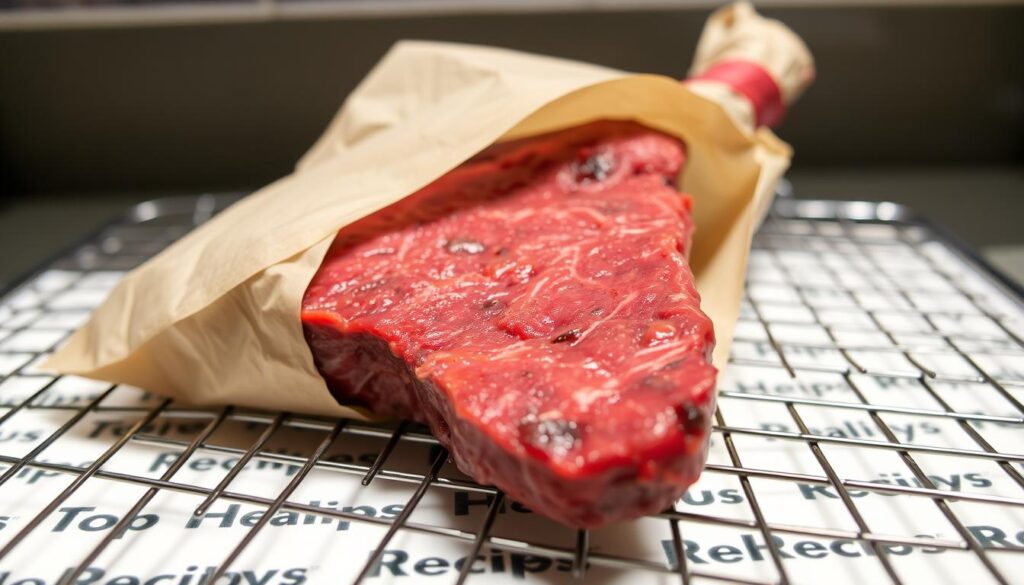
Cooked hanger steak keeps its quality for 2-3 months in the freezer. Always thaw it slowly in the fridge, giving it 24 hours for thawing a typical portion. This slow thawing helps keep the meat’s structure and moisture.
Hanger Steak vs. Other Cuts
Choosing the right steak is all about knowing the differences between cuts. Hanger steak, flank steak, and skirt steak are often mixed up. But each has its own special qualities.
Flank Steak Comparison
Hanger steak and flank steak are quite different. Hanger steak comes from the diaphragm muscle, while flank steak comes from the belly. This means they have different textures and flavors.
- Flavor Profile: Hanger steak tastes more intense and gamey. Flank steak tastes cleaner and more straightforward.
- Cooking Approaches: Cook hanger steak quickly over high heat. Flank steak can handle a bit longer cooking but gets tough if overcooked.
- Marination: Both benefit from marinating. But hanger steak soaks up flavors better, while flank steak is marinated to make it tender.
Skirt Steak Comparison
Skirt steak and hanger steak both come from the plate section but are different. Skirt steak is long and flat, with strong muscle fibers. Hanger steak is more irregular and has a central membrane.
Skirt steak has a strong grain and a bold beef flavor. Hanger steak has a milder grain and a deeper, more complex taste.
- Cooking Methods: Both need high-heat cooking. But skirt steak’s thinness makes it easy to overcook.
- Marination and Flavor Absorption: Skirt steak is great at soaking up flavors, perfect for fajitas.
- Culinary Applications: Hanger steak is best as a standalone steak. Skirt steak is great for thin slices in dishes.
Knowing these differences helps you choose the right steak for your dishes.
Where to Buy Hanger Steak
Finding the perfect hanger steak starts with knowing where to look. This cut might not be as common, but there are many places to find it. You can explore different options to get your hands on high-quality hanger steak.
Best Butchers and Markets
Independent butcher shops are great for hanger steak, thanks to their whole-animal butchery. They get entire sides of beef and cut them up themselves. This means you can get hanger steak and have it trimmed just right.
Specialty meat markets also offer premium beef, including hanger steak. You might need to order it ahead of time, but they usually have great options. Farmers’ markets with meat vendors let you buy directly from the producers. This way, you can learn about the cattle’s background.
Ethnic markets, like those serving Latin American communities, often have hanger steak at good prices. It’s important to ask about their beef sources. Grass-fed, dry-aged, or heritage breed beef can give your steak a unique taste.
| Source | Quality Indicators | Price Range |
|---|---|---|
| Independent Butcher Shops | Whole-animal butchery, trimming available | Moderate to High |
| Specialty Meat Markets | Premium beef, advanced ordering possible | High |
| Farmers’ Markets | Direct from producers, varied practices | Variable |
| Ethnic Markets | Traditional cuts, competitive pricing | Moderate |
Online Options
Online meat purveyors are a game-changer for those with limited local options. They offer high-quality hanger steak right to your doorstep. You’ll get detailed info on how it’s sourced and made.
Online butchers like Porter Road, Snake River Farms, and D’Artagnan provide great hanger steak. They tell you about the cattle, how it’s fed, and how it’s aged. Services like Crowd Cow and ButcherBox sometimes include hanger steak in their boxes.
“The rise of online meat delivery services has made it easier than ever to access high-quality, specialty cuts like hanger steak, regardless of your location.”
When buying hanger steak online, think about a few things. Check if the membrane is removed, the cut’s weight, shipping, and thawing if it’s frozen. Many online sellers give cooking tips for their hanger steak, which is super helpful if you’re new to it.
Final Thoughts: Embracing Hanger Steak
Now you know what a hanger steak is and its special qualities. It’s time to add this cut to your cooking. Using hanger steak is more than just a new ingredient. It’s a way to connect with old butchery traditions that use the whole animal wisely.
Starting your hanger steak adventure, try simple recipes first. This will let you enjoy its unique taste and texture. Try different marinades and cooking ways to see what you like best. This not only improves your cooking but also helps the environment by using meat more wisely.
Culinary Adventures Ahead
Learning to cook hanger steak opens doors to other unknown cuts. This changes how you cook and eat. By trying different cuts, you’ll get better at cooking, find new tastes, and join a tradition that values being creative.
Exploring New Horizons
Getting good at hanger steak makes you want to try more hidden gems. This journey makes you appreciate the wide range of tastes in one animal. It helps you have a deeper connection with your food.
FAQ
What is hanger steak?
What does hanger steak look like?
How do you cook hanger steak?
What are the nutritional benefits of hanger steak?
How do you choose the best hanger steak?
Can you freeze hanger steak?
How does hanger steak compare to other cuts?
Where can I buy hanger steak?
What’s the best way to store leftover hanger steak?
For more cooking tips, stay connected with us. We also recommend the cookbook Skinnytaste Simple: Easy, Healthy Recipes with 7 Ingredients or Fewer
For more Recipes about Steak ?
Did You try our recipe ?
There are no reviews yet. Be the first one to write one.
